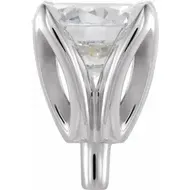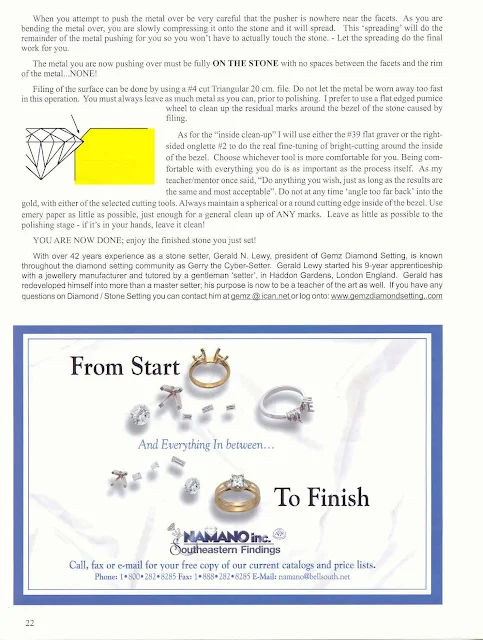Sunday, 8 June 2025
How to clean your "Hammer Face"? => 18 photos
Thursday, 5 June 2025
Do you use (thin) claw settings for a 1 carat diamond? =>14 photos
Some jewellers will offer their clients a thin 4-claw setting instead of a 6-claw setting for a 1-carat diamond.
These 4 claws blend with the 'Crown Facets'. Although these claws are wide, but are so very strong. The curved tips are 'rounded' for a purpose, as they seem almost invisible from the top.
This final choice of a setting is for a diamond of a 3/4 carat size, but refrain from anything larger. The reason is that the diamond might appear to be 'top-heavy' to the thin-looking shank.
Saturday, 31 May 2025
Techniques of "Flush Setting" a gemstone? => 7 photos with diagrams
1) After the stone has been set into the metal, remember to 'Bright Cut' the metal around the stone. This photo is the 'epitome of gemsetting perfection'.
2) This "Bright-Cutting" technique can be made with an Onglette graver that has been highly polished on the cutting side.
3) Please do not use a 'Flat-shaped graver' as the blade might touch the Facets and leave a 'rippling edge' around the bezel.
4) I would personally use Pumice wheels and gently smooth all of the surfaces nearest to the stone. Use #180 grit, then followed by #1,000 grit. Then the ring will be a wonderful thing to behold.
If you think that setting these many sizes of stones is easy, you are looking at 5 different sizes of gemstones. By the way, have the surface of the ring Tripoly-polished before stone setting. If you polish the metal after the stone setting, some of the stones might get loose! All that is needed is to 'gently' Rouge the surface.
If you have aspirations of attempting to set these gemstones, think twice. Why? Those odd-shaped stones could be a real nightmare to the jeweller or novice setter.
First, create the ring with the aid of CAD and use the computer-aided design program to guide you. There are many sizes & shapes of baguettes to contend with.
Around each of these stones were a 'Bright-Cut' to visually finish the gemstone setting.
If you need a library of 'additionally' selected Gypsy or Flush mounted stones just click on to "FLUSH SETTING".
Instead of a ream of words for you to absorb, the above diagram is just for you. "Enjoy, read and learn." - Gerry Lewy.
Wednesday, 28 May 2025
What is a "Bead Raiser" & how does it work? => 6 photos
Tuesday, 27 May 2025
(REVISED) "Casting with Gem Stones" =>12 photos & 8 text pages.
This tutorial essay was published on this blog six years ago. I'm adding new text to each page for easier reading. This is one of the most interesting 8 pages any jeweller or caster can have in their library.
This company has been in business since 1988. The owner, John Eisinger (R.I.P.), was the original owner of this company.
============================
These days, 'CASTING WITH GEMSTONES' is no longer a myth, but an actual reality; it is now a working practice.
On "Ganoksin", I often see instances where new jewellers need some helpful techniques to get started with their casting.

You have the option to make minor adjustments to the temperatures as needed.
DON'T QUENCH YOUR HOT CRUCIBLE INTO COLD WATER, ONLY 'AIR COOL'.....please!
In this photo, 'was' a decent-looking stone, but the jeweller or operator made an error and placed his green stone into his wax. Here are his unfortunate results! Both the stone and the ring are now no longer usable. Sad to see this!










.jpg)


.jpg)
.jpg)
.jpg)



%20(1).jpg)
.jpg)
.jpg)

.jpg)















.JPG)
.JPG)
.JPG)
.JPG)
.JPG)



















